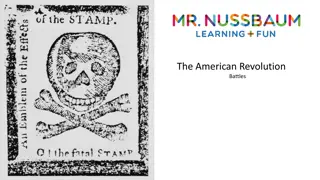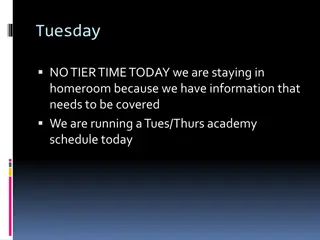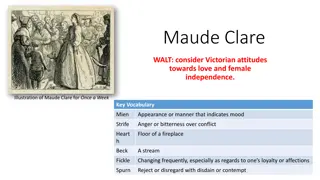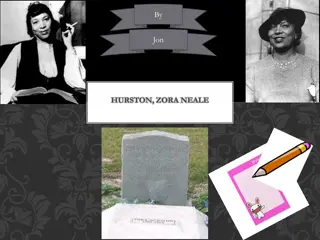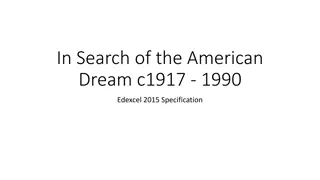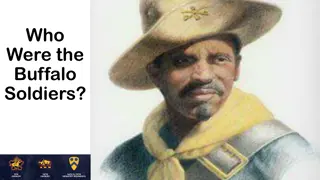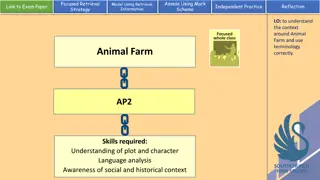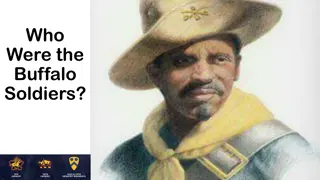The Declaration of Independence and its Impact on the American Revolution
The American colonies' journey to independence during 1775-1776 is highlighted, from initial hopes for reconciliation to the eventual Declaration of Independence. The document's significance is explored, focusing on the response it garnered, the process leading to its approval, and the outlined rights and grievances against British rule. The structure and anticipated outcomes of the Declaration are also discussed, shaping the foundation for a new nation.
Download Presentation
Please find below an Image/Link to download the presentation.
The content on the website is provided AS IS for your information and personal use only. It may not be sold, licensed, or shared on other websites without obtaining consent from the author. Download presentation by click this link. If you encounter any issues during the download, it is possible that the publisher has removed the file from their server.
Presentation Transcript
What Independence Meant The American Battlefield Trust
Essential Question How did people respond to the Declaration of Independence and interpret its meaning?
Context: 1775-1776 A year earlier most American colonies hoped the conflict with Great Britain could be resolved with their rights as Englishmen preserved within the British empire. Armed conflict started in April 1775, and the Second Continental Congress passed a Declaration of the Causes and Necessity of Taking Up Arms, outlining the need for the army to defend themselves from the British Army. On July 8, 1775, the delegates approved an Olive Branch Petition to King George III, seeking his intervention in stopping the bloodshed and restoring their rights as Englishmen. However, the King refused to accept the petition, since he had already issued his Proclamation of Rebellion. Now declared to be in rebellion and with the war raging, delegates began to think independence was inevitable. Following the recapture of Boston from the British, in the spring of 1776, the Continental Congress began looking to individual colonial governments to give permission to their delegates to vote for independence.
"That these united Colonies are, and of Right ought to be Free and Independent States" On June 7, 1776, Virginia delegate Richard Henry Lee put forward the motion to the Second Continental Congress that these united colonies are, and of right ought to be, free and independent States, that they are absolved from all allegiance to the British crown, and that all political connection between them and the state of Great Britain is, and ought to be, totally dissolved. While the Congress debated this motion over the next few weeks, a Committee of Five was established to write a Declaration of Independence in the event the motion passed. On July 2, 1776, delegates of the Continental Congress voted for independence. On July 4, 1776, the Committee of Five presented the Congress with the finalized document of the Declaration of Independence, and Congress approved it.
The Structure of the Declaration Preamble Second section Third section Outlined the rights of man and the right for the colonists to fight for their cause. The words of the preamble were meant to unite Americans under a realization that the future could be brighter if they continued to fight. Outlined the grievances against King George III to remind everyone of the tyranny that the King exercised over the colonists and thereby justify their fighting. Declared the thirteen colonies as free and independent states.
Stated & Anticipated Outcomes At war with those who oppose the independence of the United States Independence from British rule Creation of a new nation Seek alliances as a new nation Pursue commerce (economic opportunities)
Immediate Reactions A British Tract Newspapers Reporting the Declaration "On Wednesday last the Congress's Declaration of Independence of the United States of America was read at the head of each brigade of the Continental army posted in and near New York, and every where received with loud huzzas, and the utmost demonstrations of joy..." "And surely the Declaration of the American Congress is an insult offered to every one who bears the name of Briton." July 11, 1776 1776
Liberty vs. Reality in 1776 While the Declaration of Independence formed a new nation and stated "that all men are created equal, that they are endowed by their Creator with certain unalienable Rights, that among these are Life, Liberty and the pursuit of Happiness," this concept was not suddenly transforming American society. African Americans, Native Americans, and Women were not given equal freedom or standing under the laws for years to come. The Declaration of Independence was an important foundational document: defining principles of liberty and creating the United States of America.
African American Response to the Declaration of Independence Slavery existed in all 13 Colonies/States. Some African-Americans were free, and some fought for national independence, but many were enslaved. Thomas Jefferson's early draft of the Declaration of Independence included a notable paragraph, attacking King George III for allowing the Transatlantic Slave Trade to continue. During the Continental Congress's revision process to Jefferson's draft, they removed the bulk of the paragraph and reduced it to a veiled reference against slavery, complaining that King George incited "domestic insurrections among us." Later, Jefferson claimed that some delegates from northern and southern colonies had objected to the original paragraph and prompted its removal. Slavery continued to exist until 1865, and many African Americans pointed out the disconnect between the words of the Declaration of Independence and the continued practice of slavery in the United States in the years after the Revolutionary War.
Native American Response to the Declaration of Independence Native American tribes fought on both sides during the Revolutionary War, so some supported the cause of independence and some opposed it. However, the Revolutionary War cost Native Americans and altered their ways of life. In the peace treaty (1783), in addition to recognizing the independence of the United States, the British ceded to the new nation all British territory east of the Mississippi and south of Canada. This decision was made without any input from the Native Americans who lived on those lands, most of whom had chosen to side with the British precisely because they wanted to block further white settlement. When settlers did flood into the newly acquired territory, many of them justified harsh treatment and expulsion of Native Americans with the belief that all Native peoples had supported the British during the war. When Native Americans fought back against the United States, they found very little support from their former British allies. In the 18th and early 19th Centuries, the United States treated Native American Tribes as separate nations, not including them in the benefits of the Declaration of Independence and concepts of liberty despite the received support for the Revolution.
Women's Response to the Declaration of Independence While some women had a strong interest in politics and national independence, they did not have a role or vote in government. Women's rights were restricted by laws of the time, but some women envisioned a time when they would have more equality and a larger role in government. In March 1776, while considering the concepts of independence and a new government, Abigail Adams wrote to her husband: "I long to hear that you have declared an independancy and by the way in the new Code of Laws which I suppose it will be necessary for you to make I desire you would Remember the Ladies, and be more generous and favourable to them than your ancestors."
The United States Constitution & Bill of Rights The Declaration of Independence formed the United States of America in 1776. The Continental Congress and later the Articles of Confederation provided guiding governance during the Revolutionary War years. By the late 1780's, the new nation was struggling with division and quarrels. In 1787, the United States Constitution was written, providing a system of government. In 1791, the Bill of Rights was added to the Constitution to help safeguard the rights and liberties of citizens. Amendments in later decades further expanded and secured liberties.
Inspiration of Liberty The Declaration of Independence established the United States of America and a vision for liberty. These concepts of liberty have inspired other Revolutions and Declarations around the world. For example, in 1789, revolutionaries in France drafted "The Declaration of the Rights of the Man and of the Citizen", taking inspiration from the United States previous declaration.
A Continuing Quest... The statements and ideals put into the Declaration of Independence in 1776 laid a foundation for the pursuit of liberty as nations in the early modern era. While the Declaration of Independence did not function as the law of the United States, it did establish the nation and is one of the founding documents along with the U.S. Constitution (1787) and Bill of Rights (1791). The pursuit and protection of liberty is essential in each generation and has continued to expand bringing more fulfillment of the promise of "life, liberty, and the pursuit of happiness."






